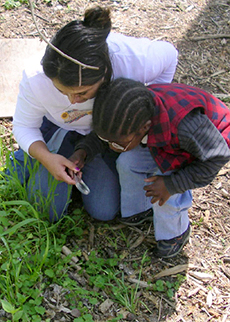Schoolyards as Habitats
What is a Habitat?

Plants and animals are not distributed randomly or evenly over the landscape. Each organism lives in an environment which best provides for its needs: food, water, cover and places to raise young. Other living things, including people, play a significant role in providing for these needs. Climate, geology, and topography also have a significant impact. The provision of those needs describes the animal’s habitat.
Natural communities are habitats that have been common in a specific region (like east central Missouri) since pre-European settlement. Natural communities of this region include forests, woodlands, savannas, prairies, glades, wetlands and streams.
Why should a schoolyard be considered a habitat?
There are living things that are receiving one or more of their basic needs from the outdoor space around school building. Even if the school building is surrounded primarily by asphalt and concrete. Those living things, and the resources that they utilize provide a rich and ever-changing context for learning, across the disciplines. As students become familiar with the habitats of the schoolyard, they have opportunity to discover new facets of the world around them and interact with those discoveries as they achieve formal curriculum goals. A significant way for students to interact with the schoolyard is for them to introduce plants that may have once been part of the local natural community, thus acknowledging and enhancing the local natural history. Investigating and modifying the schoolyard as a habitat is a means of engaging in place-based education.